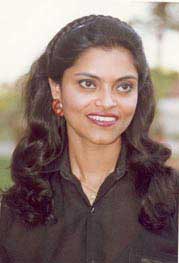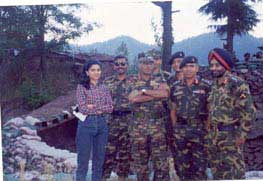Magazine
Soft Spots of a Tough Girl

Anita Pratap reports from the some of the most dangerous regions in the world.
|
Writing Island of Blood, an account of her experiences as a frontline reporter in Sri Lanka, Afghanistan, and Kashmir, was not a spur-of-the moment decision for veteran journalist Anita Pratap. As long back as 1987, Pratap remembers David Davidar, the head of Penguin books in India, urging her to put down her thoughts and insights into a work of non fiction.
“At that point, I was still jumping from place to place pursuing stories,” says Pratap. “I did not have the time to sit down and pour myself into a book. I was visiting all these regions of conflict and witnessing so much violence and waste that I did not want to come home and confront them again. My defense mechanism was to put whatever horrors I had seen aside, finish my reports and then come home to my family. Neither my son or my parents had a clue to the things I had seen and I never told them. They would have been petrified each time I went to cover a story. “ Clearly, Pratap did not intend to waste time being petrified. Ed Turner, the vice president of CNN, had obviously sized her up accurately, for he once remarked, when asked why he had hired her, that he knew she was ” a tough girl.” In her 22 year career as a reporter, Pratap has shown an amazing talent for being in some of the most dangerous regions in the world and coming face to face with some of the most powerful and some of the most helpless people of our times. She has met several times with V. Pirabhakaran, the guerrilla chief of the Liberation Tigers of Tamil Eelam (LTTE), interviewed Shiv Sena’s fiery leader Bal Thackeray, and conversed regularly with the likes of Rajiv Gandhi, K.P. Gill, Sesham to name a mere handful. She has also seen the human pain that result from war. Pratap has witnessed the desperation of women like Zubaida, a poor widow who had to risk her life to feed her young children in a Taliban regime that forbade women to work and stoned them to death if they were found earning a livelihood . And she has viewed the stark poverty of a fisherman in Sri Lanka who was driven to disobey the Indian army’s orders to move about and risk being shot, to go and catch some fish to feed his family. As the South Asia Bureau Chief of CNN, a position she held till January 1999, Pratap reported on all the major new stories in Asia, including the nuclear tests, the ethnic war in Sri Lanka, the Taliban takeover of Afghanistan, conflicts in India’s Kashmir and North East. Before joining CNN, she worked eight years as a correspondent for Time magazine, and before that, worked as a reporter for India Today, and for Sunday, which is where she made her mark with her reports from Colombo, Sri Lanka, on the 1983 riots that targeted local Tamils and Indians. The idea of writing a book about her experiences germinated however, in the back of her mind. In 1990, when her son went off to law college, Pratap found herself alone at home and hating it. Instead of pining for her son, she decided to start a new life and got married to Arne Walther, the Norwegian ambassador to India. Soon after that, Pratap traveled to Oslo, Norway for a six-month stay. “It was the first time in my life that I had so much free time,” she laughs. And all those sights and scenes pushed away deep in her head began to tumble out. Walking along a narrow, winding mountain path in Norway, she almost bumps into a rosy-cheeked young boy on his bike. Pratap found herself remembering Afghanistan, another mysterious mountain region she had gone too. But there the young men she had seen did not have flushed, healthy faces. Their faces were charred with explosions or lined with suffering. She began work on the book and although the chapters started piling up, the book developed in a manner that was not quite what Davidar had envisioned. “David wanted a straight-on book. An account of my days in the jungles of Sri Lanka interviewing Pirabhakaran, or sneaking into Afghanistan in a burqa to reveal the atrocities of the Taliban regime,” says Pratap. “But I found that I had to write about my daily, normal life too: holidaying with Arne on a cruise ship in Norway or enjoying a road trip with my son, Zubin. These were the happy, carefree times of my life, the underpinning, if you will, of my life as a hardcore reporter. And my life was worthwhile because of these joyous moments. I talked about my experiences while doing the story, but I also talked about what was happening in my own life.” Pratap convinced Davidar to keep the book exactly as she had written. And her conviction was vindicated when the book came out in India in October 2001. ” My book sold out in six days,” she gloats. “Ordinary people really related to my instinct to juxtapose the ordinary with the horrific events that I saw. They wanted the story behind the story.” Initially, Pratap had no intention of the book being published outside India. “With my experience at Time and CNN, I know how to write for an international audience, but my book was primarily meant for Indians,” she says. “But in the aftermath of September 11, I realized that the things I talk about in my book were very relevant in the US too.”
The events described in the book still have the power to move her to tears. These include the gruesome sight of seven young men, tortured with their throats slit, tied together with burning car tires around each neck lying in the middle of the road in Kandy, Sri Lanka ; the young vegetable seller in Kabul, Afghanistan, whose skin suffered ninety-eight per cent burns when he was caught in a gunfire ; and the screaming faces of children searching for their mothers during the riots that shook Bombay in the aftermath of the destruction of Babri Masjid. While writing the book, Pratap frequently found herself trembling and weeping as she relived the images that had been hidden in her brain. And when she talked to people during her book tour in India, Pratap could not stop her tears as she narrated some of her experiences. “All the terrible things I saw affected me. I’m not the stereotypical, hard bitten, cynical journalist,” she says. “The cruel scenes I have witnessed have been gouged deep in my consciousness.” As a journalist she may have repressed her personal trauma at seeing the torn limbs of children and the bits and pieces of body parts of suicide bombers and concentrated on getting her article out, but Pratap values her sensitivity highly. So much so, that on the day that CNN asked her to go to Bombay to cover a bomb explosion, when Pratap’s first, unschooled reaction was not horror or sorrow, but a tired “Not again. Not another bomb,” she decided to resign. She knew then that her days of going out in the field and hunting down the story were over. “I believe that there are two things that are bad for a journalist: to stagnate or to be cynical,” says Pratap. ” My reaction told me that fatigue had set in. My mind was not focusing on the horror or the pain to humanity but my own tired brain. It was time to call it quits.” Pratap’s guardian angel must have been equally hyperactive doing those busy years. Her need to keep moving in areas where she had to dodge bullets could have ended Pratap’s career very abruptly. She came close to dying numerous times, always rescued at the last second, some times by just turning her head and missing the bullet that went past.”Why did I move my head at that precise moment?”wonders Pratap. “Why was the jeep I was traveling in stopped just before it would have gone over a land mine?” She attributes it to divine protection and to her survivor instinct. “All of us have that instinct,” she stresses.”Especially women, even the most sheltered ones, because they are very canny and have a strong will to live.” Pratap hopes that readers of her book will come away with a deeper appreciation of the normal, every day blessings of life. “That’s what kept me centered all those years I was out there covering death and destruction,” she says. “I had a home, a family to come back to. And they taught me to celebrate the ordinary.” These days Pratap concentrates on writing opinion pieces for magazines and bringing out documentaries, which she directs, reports, scri pts and narrates on such diverse topics as Indian dance and music and the remarkable transformation of Mizoram from an insurgent state to a model democracy. When she hreflects on her days as a field reporter it is with a sense of satisfaction and pride. “I was a trail blazer,” Pratap agrees, with a smile.”But at that time, all I knew was that I was doing my job. Today I am proud that I did it by sheer hard work, with no godfather in the profession to help me up.” She has no regrets, she insists about her life, not even her failed marriage, for not only did it give her son, Zubin, but led her to move with him to Madras and begin working as a correspondent for Sunday magazine, the starting point of her famous career. Pratap is not about to sit still and dwell on her laurels though. She is working on a second book, another non fiction, this time about a tiny Indian village untouched by all the amenities that the modern society takes for granted. “I’ll be busy with my second book for the next two years. I never plan beyond a week, anyway,” she laughs. “So I just plan to keep going and doing what I have to do.” |



You must be logged in to post a comment Login